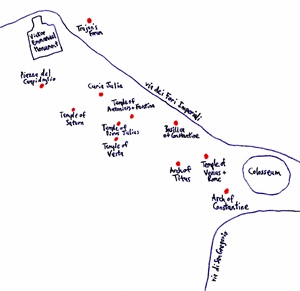
Map of Forum Area
Back to Colosseum Continue to Pantheon
For
centuries, the main Forum was the political center of
We
began our exploration of the Forum from its east end, near the Colosseum. The entrance was just up Via di San Gregorio
from the Colosseum, where there was a fairly short line to wait in. The first ruins seen, also visible from the
Colosseum area, were those of the

Temple of Venus and Rome
Temple of Venus and Rome
HD Video (14.5 MB) SD Video (4.8 MB)
Columns, Temple of Venus and Rome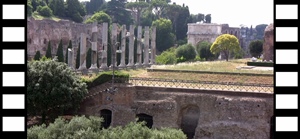
Columns, Temple of Venus and Rome
HD Video (9.5 MB) SD Video (4.4 MB)
Continuing
westward past the
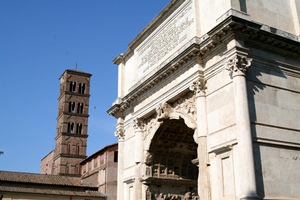
Arch of Titus
Arch of Titus
HD Video (19.3 MB) SD Video (9.1 MB)
South
of the Arch of Titus we could see the Palatine Hill, which was included in the
combo ticket, but which we did not have time (or energy) to visit. To the north
were the three surviving immense chambers of the Basilica of Maxentius and
Constantine, which was built between 308 and 312 A.D. and was used for purely
administrative and political purposes in ancient
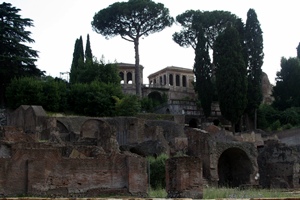
Palatine Hill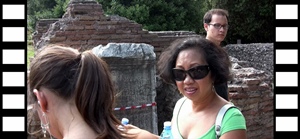
Forum, Palatine Hill and Basilica
HD Video (20.2 MB) SD Video (7.2 MB)
At
this point the path into the Forum proper began to descend, and we found a
smallish circular structure to our right called the
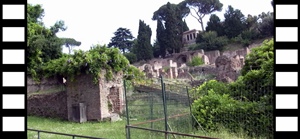
Descending, Palatine Hill, Ruins
HD Video (19.6 MB) SD Video (12.2 MB)
Descending Toward Forum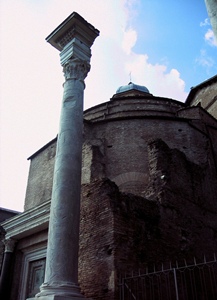
Temple of Romulus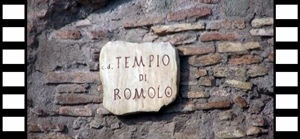
Temple of Romulus, Temple of Antoninus & Faustina
HD Video (20.1 MB) SD Video (7.6 MB)
An
even more striking combination of pagan and Christian architecture stands next
to the Temple of Romulus, this being the Temple of Antoninus and Faustina. The temple was begun in 141 A.D. by the
emperor Antoninus to honor his deceased wife, Faustina, whom he’d deified. After Antoninus died, the dedication was
extended to him as well. At some point,
possibly the seventh Century A.D., a Christian church appeared inside the
temple, the

Temple of Antoninus and Faustina
Temple of Antoninus and Faustina
At
this point we found ourselves surrounded by ruins in all directions. To the left of the
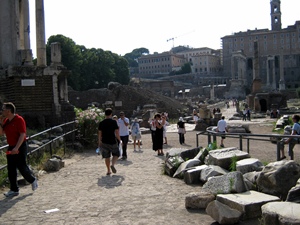
Philip Entering Forum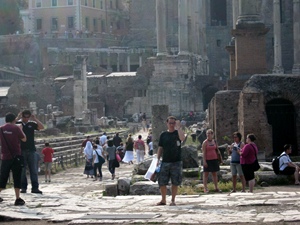
Philip in Forum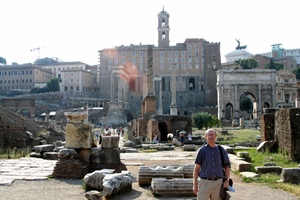
Bob in Forum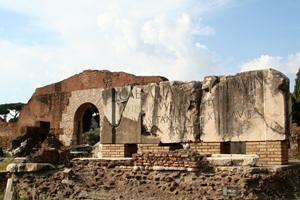
Basilica Aemilia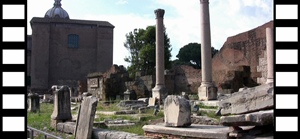
Basilica Aemilia, Temple of Antoninus & Faustina
HD Video (20.5 MB) SD Video (8.8 MB)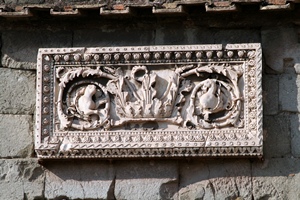
Relief, Basilica Aemilia
Connie and Temple of Caesar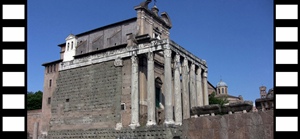
Temple of Caesar and Surroundings
HD Video (18.8 MB) SD Video (7.4 MB)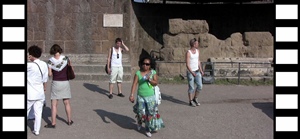
Nella Emerging from Temple of Caesar
HD Video (19.8 MB) SD Video (9.3 MB)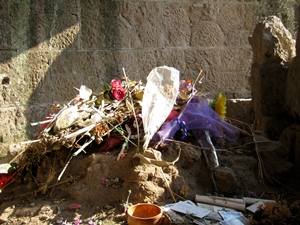
Flowers on Remnants of Altar
Further
south is the partly-reconstructed
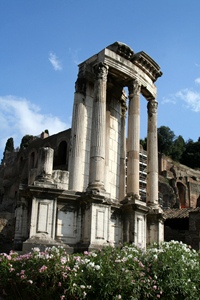
Temple of Vesta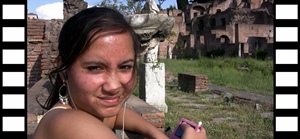
House of the Vestal Virgins
HD Video (20.4 MB) SD Video (7.4 MB)
To
the west of the

Temple of Castor and Pollux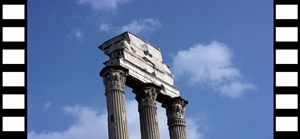
Temple of Castor & Pollux, Temple of Vesta
HD Video (20.4 MB) SD Video (9.3 MB)
Back
on the north side of the Forum, next to the Basilica Aemilia ruins, is a large,
brick-covered building that is largely intact, and therefore not obviously
ancient. This is the Curia Julia, which
dates back to 283 A.D., at which time it was rebuilt by Diocletian
(construction of the original building was begun by Julius Caesar in 44
B.C.). It was completely restored by
Mussolini in 1937-38. The cavernous
building was used as a meeting place for the Roman Senate, and was capable of
seating 465 people, if benches were used.
On display in the building are two relief panels, originally used as
decoration for the Rostra, or speaking platform, near the Curia. The panels depict altruistic acts by the
emperor Trajan.
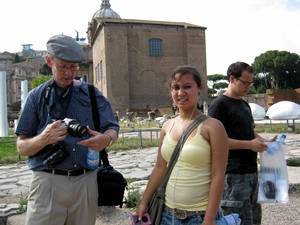
Bob, Connie, Philip and Curia Julia
Curia Julia
Curia Interior
HD Video (13.6 MB) SD Video (3.2 MB)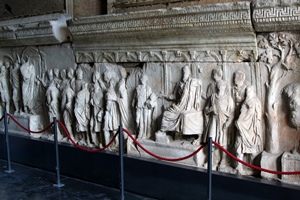
Relief Panel
The
Arch of Septimius Severus is also found near the Curia. It was dedicated in 203 A.D. to commemorate
victories in campaigns against the Parthians (who lived in the area of what is
now
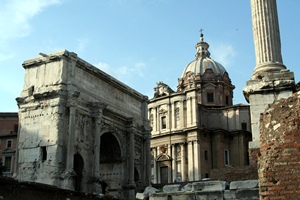
Arch of Septimius Severus
Column, Rostrum, Arch of Septimius Severus
HD Video (10.9 MB) SD Video (3.3 MB)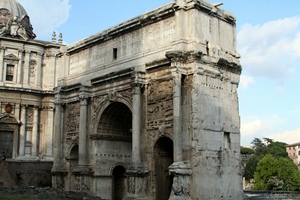
Arch of Septimius Severus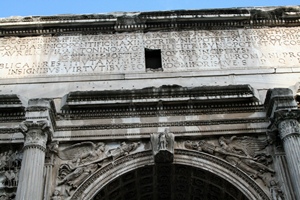
Inscription, Arch of Septimius Severus
South
of the Arch are the eight remaining columns from the portico of the
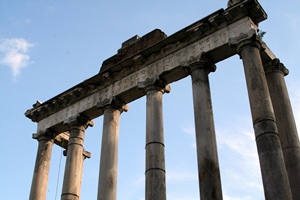
Temple of Saturn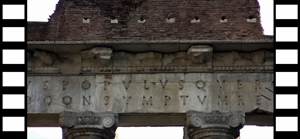
Temple of Saturn, Temple of Vespasian
HD Video (21.9 MB) SD Video (5.3 MB)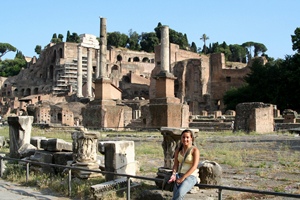
Connie and Ruins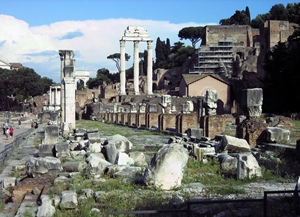
Southwestern Forum
We
exited the Forum at the west end and crossed the Via dei Fori Imperiali to see
the Forum of Trajan, which was built by the emperor Trajan and his chief
architect, Apollodorus of Damascus, being completed in 112 A.D. The large semicircular structure of Trajan’s
Markets remains; this was an early shopping mall. Several short columns remain in front of the
Markets – these were once part of the Basilica Ulpia.
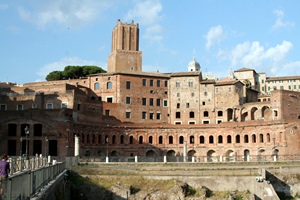
Trajan's Markets
Columns, Forum of Trajan
Back
across the Via dei Fori Imperiali, we couldn’t miss the immense (and much
newer)